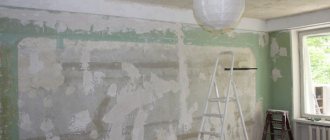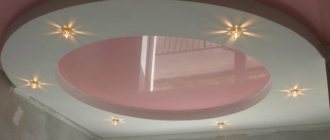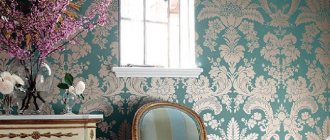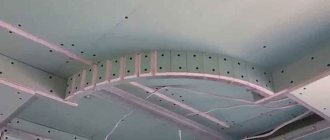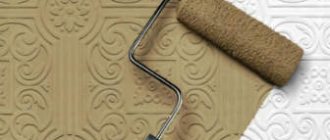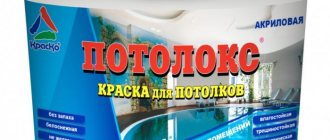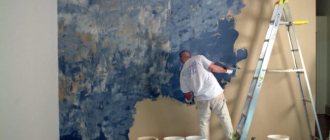Shells for stretching ceilings can be divided into 2 groups based on the material they are made of:
- from PVC (polyvinyl chloride film);
- fabric.
The canvases of these groups differ from each other not only in the numerical values of the characteristics of the same name, but also fundamentally.
An example of the difference in magnitude. The specific weight of a stretch ceiling made of polyvinyl chloride film ranges from 180 to 320 g/m² with a fabric thickness of 0.15 to 0.35 mm, and one square meter of fabric material usually weighs 200 g and has a thickness of 0.25 mm.
The fundamental differences are due to the structure of the materials. Film stretch ceilings are made from PVC film, and fabric stretch ceilings are made from knitted fabric (polyester) impregnated with polyurethane. That is, both materials are made of polymers, and the name of the “fabric” group is conditional. But in one case, polyvinyl chloride is used in the form of a film, and in the other - as an impregnation, and it is the method of using the PVC component that determines the difference in the structure and, as a consequence, the physical characteristics of the shells.
Justification for the unsuitability of PVC films for painting
Film sheets are durable and elastic - after heating, the dimensions of the film can be increased by 20% by stretching. As it cools, the canvas completely straightens, while maintaining strength, but this strength is relative. If you pour water onto a stretched shell, as happens when there is a leak from above, the film will accept it and stretch, but will not tear. However, in another situation, even a slight impact on the stretch ceiling with a sharp object, for example, when cleaning, will lead to its rupture. These properties of the film are due to the absence of reinforcement in the material.
Is it possible to paint film stretch ceilings, what will happen to the PVC film after painting? The use of water-dispersed compositions for painting is ineffective - there will be no adhesion of the paint to the surface of the stretch ceiling, and after drying it will crumble.
The consequences of using synthetic paints and varnishes when painting the entire surface of the decorative shell will be even more disastrous. Under favorable circumstances, the unreinforced film will sag under the weight of the applied layers of paint, the rigidity of which, after drying, will not allow it to straighten out. In the worst case, the paint and varnish composition will corrode the shell, and it will spread under the influence of the existing tensile force.
The film canvas can be given a second life by applying drawings using airbrushing. But, if the homeowner himself does not master this art, then the cost of services for such a design of a suspended ceiling will exceed the price of a new canvas.
Possibility of painting fabric stretch ceilings
Polyester canvas, which is the basis of a fabric stretch ceiling, after impregnation on both sides with a polymer composition, does not lose its function as reinforcement. The low elasticity of the shell in this case is an advantage - applying several layers of paint to its surface does not cause the fabric to sag.
The surface of fabric shells, due to the specifics of manufacturing technology, cannot be glossy - only matte. This texture is more difficult to clean from contamination, but it provides better adhesion of paints and varnishes to the base.
With the right choice of paint, fabric stretch ceilings can be painted repeatedly, which is what their original state is like - a white canvas, on which, depending on the model, a single-color color or artistic design is applied using photo printing or manually.
Is it possible to paint a fabric stretch ceiling?
Stretch ceilings have many important advantages over currently existing finishing options. However, even the smoothest and most flawless ceiling covering can simply become boring over the years or require cosmetic repairs. In this case, ordinary people often ask whether it is possible to paint a fabric stretch ceiling. If so, what paints can be used for this coating? Let's look at these questions in more detail.
Is it possible to paint suspended ceilings?
If you want to change the appearance of the ceiling finish or hide stubborn stains on the stretch ceiling, you will probably decide that the only solution is to completely replace the coating. However, you should not rush to spend money on a new ceiling: if you have a polyester fabric structure installed, you can simply repaint it.
Paint selection
Acrylic paint is best suited for painting suspended ceilings. It dries quickly, lays down smoothly, and also does not have a strong unpleasant odor. In addition to paint, you will need a spray bottle or roller.
If you are painting for the first time, it is best to choose a sprayer. This will allow you to apply the paint as evenly as possible. If you prefer a roller, it should be as soft as possible, ideally made of latex. It is better not to use a fluffy roller - it will leave air bubbles. Evenness of application may also be affected.
The result of painting fabric ceilings
The high cost of fabric ceilings is due to the complexity of the structure. The polyester fabric is covered with:
- on the inside with waterproof varnish that protects against leaks from the upper floor or roof;
- on the outside, first with a dense polymer that is not afraid of damage, plus a finishing layer of varnish that gives the ceiling an excellent appearance (the varnish is practical, dust does not stick to it, dirt is easily removed).
Unlike PVC, the fabric does not sag. They produce three types of fabric texture:
- glossy ones are good because they do not fade, they look noble, but any defects on them are immediately noticeable;
- matte ones retain their color in any light, these affordable coatings are durable, but their color range is limited;
- satin is a cross between gloss and matte stretch coating; their texture imitates fabric.
The fibrous frame protects the coating from tension under the weight of the paint layer. Any type of fabric surface adheres well to painting. The only thing worth focusing on is the chemical composition of the base. Some solvents are harmful to polymers. Craftsmen recommend conducting a compatibility test: apply a drop of paint to the fabric in an inconspicuous place on the ceiling structure and leave it until dry. After this, the strength of the tension material is checked. If a small defect appears under the painted fragment, it is better not to risk it.
Nuances
Unlike standard concrete bases, which can be painted in separate small sections, a suspended ceiling must be painted a little differently - in stripes. That is, you need to apply paint along the entire length of the ceiling at once. The second strip should lie next to the first, slightly overlapping it.
Depending on the type of canvas, it may require more or fewer layers of paint. The lowest quality and cheapest types of suspended ceilings require a more careful approach and may not withstand more than three to four layers.
A high-quality canvas that can withstand a larger amount of paint applied to it. Here the number of layers can reach up to ten. It is also worth considering the area of the room - the larger it is, the heavier the painted surface will be and the higher the risk of sagging.
Painting technology
The work process consists of preparatory work and direct application of paint to the suspended ceiling. You have to choose the right tools and materials to do the job.
Materials and tools
Water-based compositions are used to paint fabric ceilings. The best paint option is latex. Provides coating viscosity (which is important for stretched fabric) and adheres well to the surface. If latex paint is not available, a high-quality water-based paint will do. Most often, white paints are purchased for painting, which, if necessary, are tinted.
Organic-based compositions or those containing nitrocellulose are not suitable for painting ceilings. The problem here is not the blocking of pores in the base material, since any suspended ceiling is a shell impenetrable to air. Organics are not suitable for another reason: they disrupt the structure of the fabric, weakening the rigidity of the material.
It is better to use a spray gun as a working tool rather than a roller: this way the surface is treated more delicately and the paint is distributed as evenly as possible. There are many different models of spray guns on the market. It is not necessary to buy expensive pneumatic spray guns; a manual modification will do just fine.
Preparatory work
First you need to clean the surface from dust, oil stains and any other contaminants. This should be done with delicate detergents. The sponge should be soft, made of foam rubber (flannel fabric will also work).
To avoid staining anything during work, the room should be cleared of furniture and household appliances. It is recommended to cover foreign surfaces with plastic wrap or sheets of thick paper.
Drafts should be avoided in the room, so the doors to the room should be closed until the paint has completely dried. Direct sunlight should not be allowed on the freshly painted surface (windows must be curtained).
Tool preparation
You will need the same set of basic tools and devices as when working with a regular concrete surface. The list of what you will need is not very long:
- Roller with medium pile. It gives the best quality of coverage when working with stretched fabric.
- A painting tray or cuvette into which the coloring composition will be poured.
- A narrow brush for painting complex and hard-to-reach areas of the ceiling.
- Painting tape to protect the walls.
- Film to cover the floor.
Is it possible to paint a PVC stretch ceiling?
PVC or polyvinyl chloride is a material whose properties do not allow it to absorb and hold any type of paint on the surface. Moreover, the solvents contained in most paints and varnishes can simply corrode the canvas. After such manipulations, the canvas will need to be dismantled and replaced with a new one.
If your desire to change the color of the ceiling is irresistible, you should contact SkyPRO in St. Petersburg to replace your ceiling with a new one. Moreover, the choice of color solutions for PVC canvases is truly huge. From a financial point of view, the process of changing paintings is affordable.
Choosing the color of the ceiling
Pastel blue, pink and lilac shades are very relevant for bedrooms or children's rooms. These colors induce relaxation and calm the human nervous system.
Purple and blue tones are great for offices and living rooms. These colors stimulate mental activity and also impart calmness.
Pink ceiling with butterflies is perfect for a girl's bedroom
The size of the room is also important:
- low ceilings can be compensated as follows - a light ceiling covering and the darkest possible floor;
- if the height of the walls is too high, make the ceiling dark. The room will feel much more comfortable;
- in rooms that are not too bright, it is best to decorate the ceiling in sunny and light colors;
- for rooms that are too sunny, a ceiling in cool green or turquoise shades is ideal;
- Orange, yellow and coral tones are ideal for the kitchen. They increase appetite. If you want the opposite effect, you can decorate the walls and ceilings in blue or purple tones.
Now you know everything about whether it is possible to paint stretch and suspended ceilings, as well as how to do it correctly.
Preparatory work
To ensure that repairs and painting take place with as little loss as possible, the space must be cleared of furniture before starting. If this is not possible, carefully and futilely cover it with film or paper to avoid damage or contamination.
Next, it is proposed to clean the exterior from gunpowder, dirt, old paints, stains and oils using a soft foam-based sponge, after moistening it with gentle detergents.
After applying the dye to the tension covering, it is important that the room does not receive direct sunlight and there are no drafts, so it is important to tightly close the doors in the room being treated.
If the room is large, flooring is required. The paint is applied in tears, otherwise there will be no uniform painting.
Suspended plasterboard ceiling
A plasterboard ceiling simply needs to be painted.
A suspended plasterboard ceiling is in no way inferior in popularity to stretch ceilings. With their help, you can create any design on the ceiling, as well as create multi-level lighting. But now we will talk about painting the plaster ceiling. Can it be painted and what paint should I use?
Choosing paint
There are no strict criteria when choosing paint for a suspended ceiling. The only option that professionals do not recommend using is oil. It practically does not allow air to pass through, which can have a bad effect on the material. Lack of ventilation can lead to mold or mildew. This is especially true for rooms with high humidity.
It is best to pay attention to water-based or water-dispersion paints. A ceiling painted with this paint “breathes”; its composition has excellent ability to allow air to pass through. In addition, these types of coating provide a matte effect and can be washed. It is even possible to apply glossy enamel, but we do not recommend this. This paint will highlight all the imperfections of the ceiling. It is also extremely difficult to apply evenly and without drips. Enamel paints smell strong and take too long to dry, making them not a good choice.
Proper preparation of the ceiling is the key to successful work
We putty defects
Painting plasterboard ceilings always begins with preliminary preparation. To do this you need:
- prime the seams . The structure of plasterboard sheets is such that in their middle part (between the cardboard coverings) there is a gypsum layer that needs to be primed. Especially in those places where the material is cut. Therefore, important attention must be paid to the quality of the primer of the joints and the places where the gypsum board sheets were drilled for screws;
- sealing seams . This is the next step, which should be approached very responsibly, since any unevenness will be noticeable after painting. First prepare the putty. If it is presented in the form of a dry mixture, it is diluted with water until a suitable consistency is obtained. On sale you can also find ready-made putty compositions that do not require preliminary preparation and are immediately ready for use;
- to the joints of adjacent sheets. It will improve the adhesion of the putty and securely seal the seams. Serpyanka is glued before the ceiling is puttied or after the first layer of putty mixture is applied.
When installing a serpyanka, you need to pay attention to the following points:
- the tape is fixed strictly in the middle of the seam;
- individual pieces are glued overlapping;
- the material must be pressed into the seam as much as possible;
- Excess putty is immediately removed from the tape before it hardens.
Serpyanka will help to avoid cracking of joints in the future, so its use is mandatory;
ceilings are puttied in one of the following ways:
- one layer of putty is applied, then after drying the surface is sanded and coated with a primer;
- First, putty is applied using the starting composition.
Next, all uneven surfaces are rubbed with sandpaper, and another layer of the mixture is applied. After drying, the surface is sanded again. The next step is to glue the fiberglass to the ceiling.
Gluing fiberglass to the ceiling
It will improve the adhesive properties of finishing materials, prevent the coating from crumbling and stretching. At the end, the ceiling is covered with a layer of finishing putty, sanded and primed again. Such preparation of the base will give the best results; the ceiling will be perfectly smooth and even.
Step-by-step instructions on how to prepare a ceiling for painting.
Before decorative finishing of plasterboard ceiling surfaces, you will need to prepare tools for painting:
- high-quality fur roller;
- brushes of a suitable size;
- container for the coloring composition.
If you want to give the ceiling a different shade, purchase the desired color.
